Key takeaways:
- Creating a clear medication list with dosage, frequency, and purpose facilitates effective communication with healthcare providers and empowers patients in managing their health.
- Establishing a consistent medication schedule by associating intake times with daily activities and utilizing tech reminders enhances adherence and reduces anxiety.
- Regularly assessing and adjusting the medication regimen in consultation with healthcare professionals is essential for aligning treatments with evolving health needs.
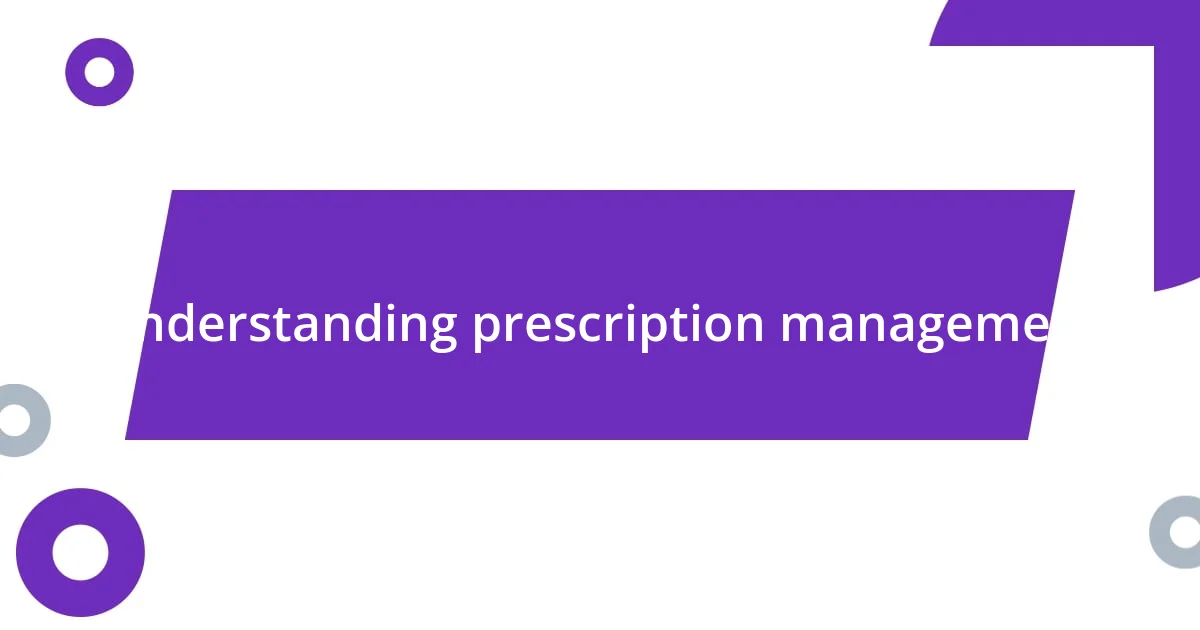
Understanding prescription management
Managing multiple prescriptions can feel overwhelming, and I know what that’s like all too well. I remember a time when my medication schedule was a complex puzzle, with different dosages and timing for each. It made me wonder, how do others keep track without feeling like they’re constantly juggling?
Understanding prescription management isn’t just about knowing what pills to take and when; it’s about creating a system that works for you. I found that using a simple pill organizer significantly eased my anxiety around medication reminders. It transformed what felt like chaos into a manageable routine, allowing me to focus more on my day rather than worrying about missed doses.
Another crucial aspect of effective management is communication with healthcare providers. I’ve often jotted down questions or concerns before appointments, ensuring I’m proactive in discussing my prescriptions. It’s amazing how a small conversation can lead to clearer guidance and can aid in adjusting treatments that best fit my needs. Ever had that moment where a simple clarification led to a brighter understanding of your treatment plan? It’s empowering!
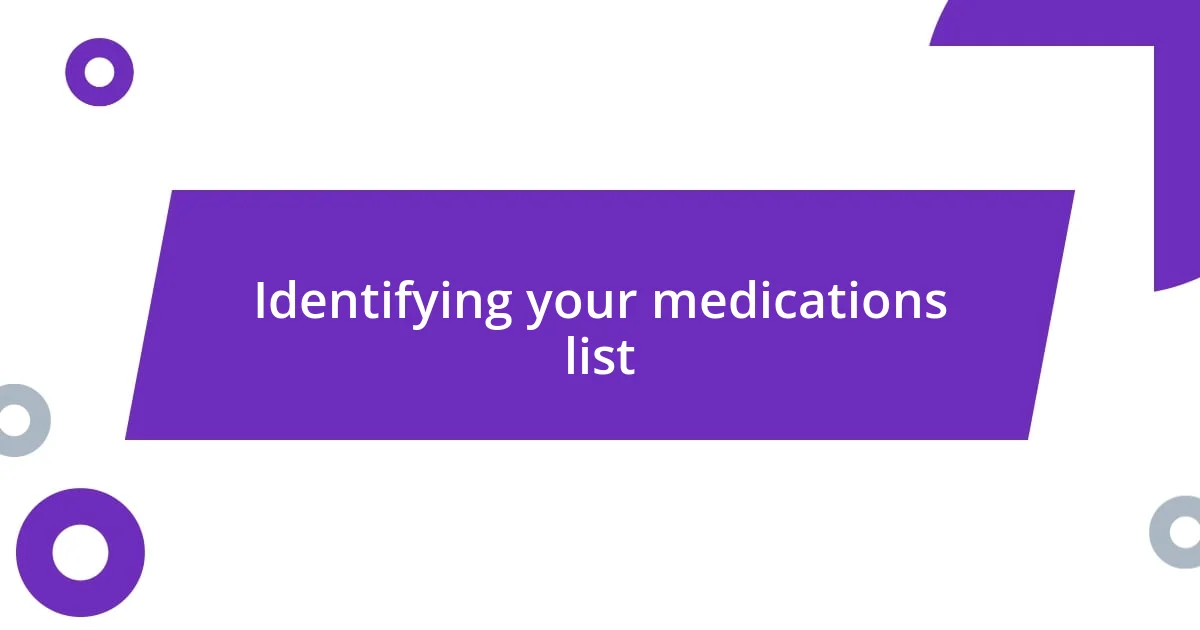
Identifying your medications list
Identifying your medications list is an essential first step in managing multiple prescriptions effectively. I recall the overwhelming moment when I opened my cabinet, staring at an array of bottles and wondering how on earth I could keep track of everything. I realized that creating a clear, organized list of my medications not only provided calm in the chaos but also made discussions with my healthcare providers smoother and more efficient.
To help you get started, here’s a handy checklist for building your medications list:
- Name of the medication
- Dosage (e.g., 10 mg)
- Frequency (e.g., once daily, twice daily)
- Purpose (e.g., blood pressure control)
- Prescribing doctor’s name
- Prescription renewal date
When I put this list together, it felt like I’d taken charge of my health, rather than letting it control me. It added a layer of clarity that helped me immensely when it came time to review my medications or discuss any potential changes with my doctor. There’s a sense of empowerment in knowing exactly what you’re taking and why.
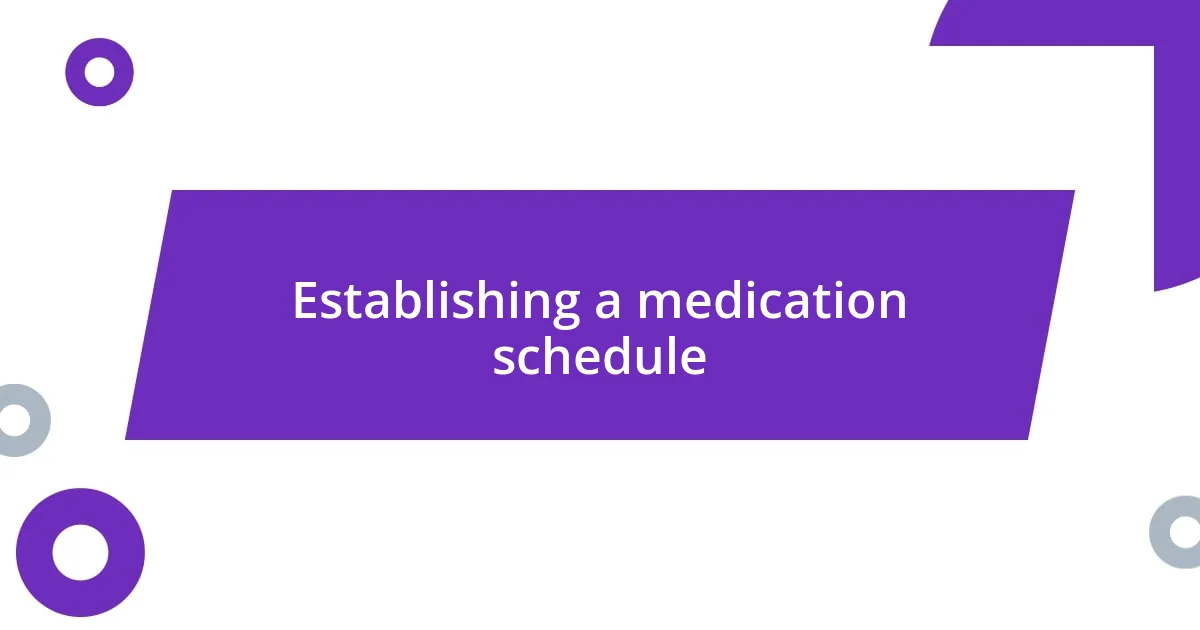
Establishing a medication schedule
Establishing a medication schedule is like laying down a roadmap for your health journey. I found that when I created a consistent daily routine, it alleviated a lot of the stress I felt about taking multiple medications. For instance, I began associating my pill-taking times with daily activities—like having breakfast or brushing my teeth. This simple trick transformed these moments into reliable reminders, ensuring I never missed a dose.
One of the key components of a successful medication schedule is timing. I remember a particularly hectic week when I forgot to take one of my medications simply because it wasn’t integrated into my routine. It dawned on me then that grouping medications by similar timings could help. I started organizing my prescriptions by their frequency—some taken in the morning, others just before bed. This strategy not only streamlined my process but also ensured I was taking my medications when they were most effective.
As you think about building your own schedule, consider using technology to your advantage. I’ve discovered that setting alarms on my phone or using medication management apps makes all the difference. There was one occasion where I was out with friends and almost forgot a dose. My phone buzzed right on cue, reminding me that it was time to take my medicine. The balance of social life and medication adherence can be tricky, but with a solid schedule and reminders, it’s manageable.
| Method | Benefits |
|---|---|
| Daily Routine | Creates structure, reduces anxiety |
| Timing Grouping | Improves adherence, maximizes effectiveness |
| Tech Reminders | Enhances convenience, keeps you accountable |

Using tools for tracking prescriptions
Using tools to track prescriptions can significantly ease the burden of managing multiple medications. I remember the early days of my prescription journey; I was constantly scribbling notes on random pieces of paper, hoping I wouldn’t misplace anything. Transitioning to digital tools, like medication management apps, brought a refreshing sense of organization. I felt liberated having everything in one place—there’s something about seeing your entire medication regimen neatly outlined that really calms the mind.
I’ve found that some apps not only track dosages and schedules but also send alerts when it’s time to refill prescriptions. This feature has saved me more than once from the panic of realizing I was down to my last pill on a Sunday evening. Have you ever had that sinking feeling when you realize you missed a refill? It’s frustrating, and technology can help you dodge that stress. By using reminders effectively, I’ve turned what once felt like chaos into a manageable routine.
Physical tools, like medication organizers with compartments for each day, can be a game changer, too. I invested in a weekly pill box, and it was like adding an extra layer of safety. Each time I opened that box and saw the week’s supply neatly laid out, it gave me peace of mind. I’ve learned that these visual cues can relieve anxiety and boost adherence. Have you ever experienced a moment of doubt about whether you took your medication? These tools not only support regularity but also reinforce confidence in your medication management journey.
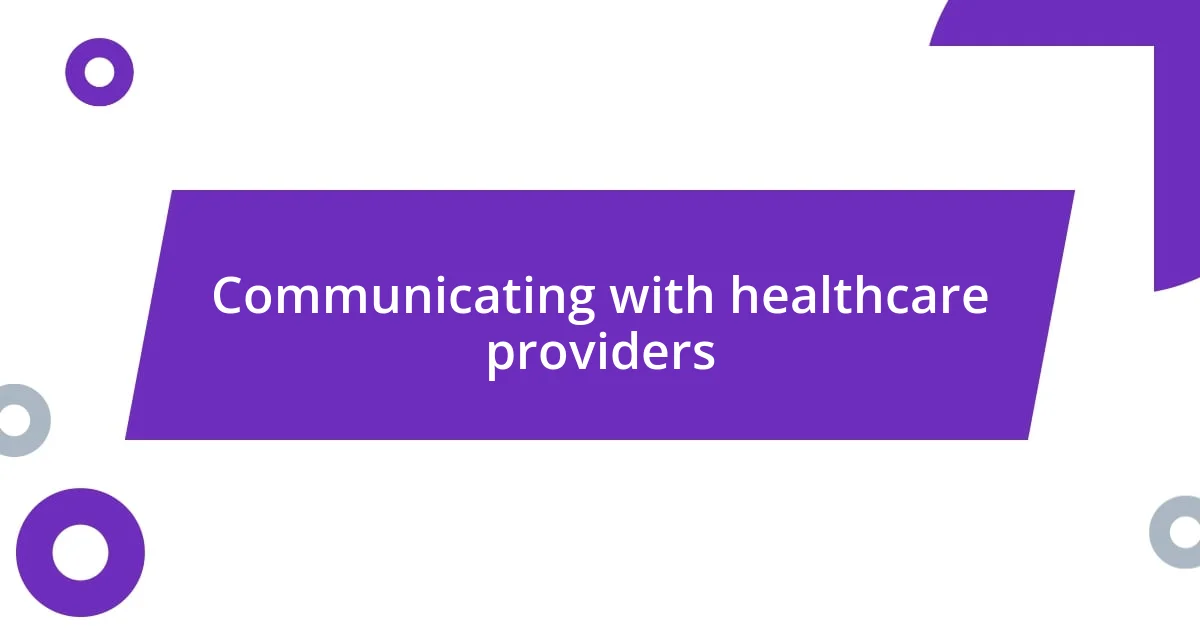
Communicating with healthcare providers
When communicating with healthcare providers, clarity is key. I remember a time when I walked into a doctor’s office with a laundry list of questions about my medications, feeling a bit overwhelmed. Instead of just rattling off my concerns, I took a moment to organize my thoughts beforehand and even wrote down my questions. This not only made the conversation smoother but also ensured I got the information I needed without feeling rushed. Have you ever left a medical appointment wishing you had asked something? That feeling is all too familiar.
I’ve learned that being open about my medication experience is crucial. One time, I mentioned a side effect I was experiencing, and it turned out that my doctor could easily adjust the dosage. Just sharing that my energy levels had dipped led to a new prescription that made a world of difference. It’s important to remember that our healthcare providers want to help; they just need us to speak up. So, when you have concerns, don’t hesitate to voice them.
Utilizing a medication list during consultations can also enhance communication. I developed a concise list that included each medication I was on, dosages, and the purpose of each. The first time I handed it to my doctor, I saw their eyes light up with appreciation. Having that visual aid helps both you and your provider stay on the same page, allowing for better-informed decisions. What happens when you blend organization with openness? You create a foundation for more effective healthcare.
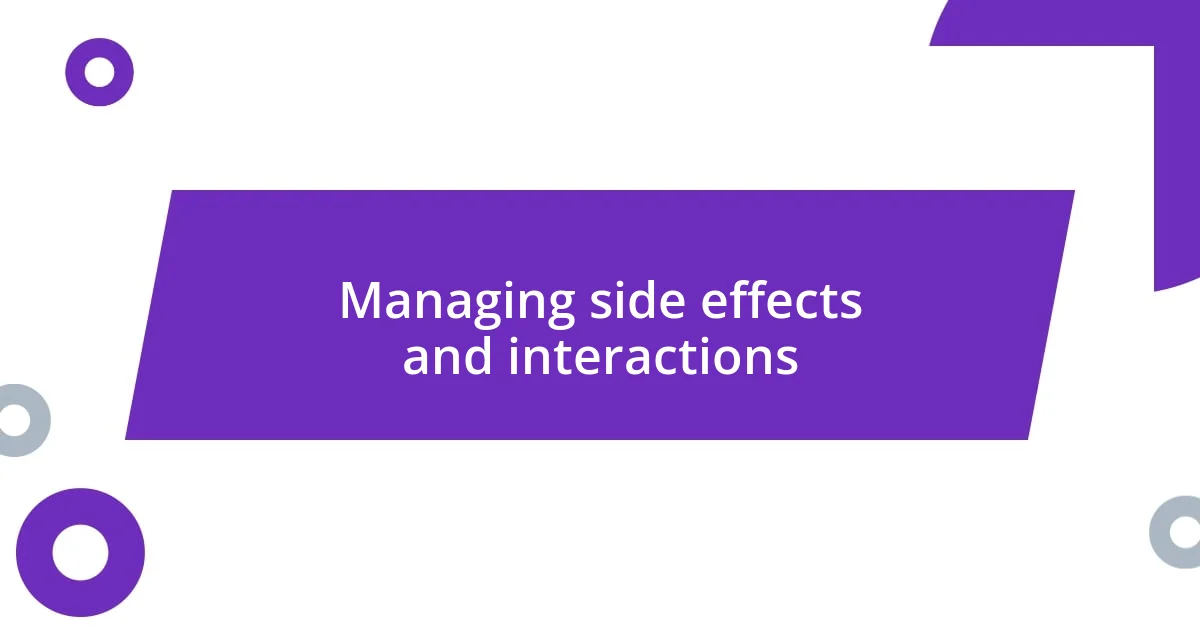
Managing side effects and interactions
Managing side effects can feel like walking a tightrope, especially with multiple prescriptions. I recall a particular episode when I was juggling three different medications, and the fatigue was unbearable. I reached out to my pharmacist, who helped me identify overlapping side effects. I learned that clear communication about what I was feeling was vital. Have you ever felt like you were battling a side effect monster without a map? Trust me, open dialogue can turn that chaos into clarity.
Interactions between medications can be tricky, and I vividly remember the time I mixed a new prescription with my existing medications. Within hours, I felt dizzy—something I had never experienced before. After just one quick call to my healthcare provider, it became clear that one of my medications increased the side effects of the new one. Preventative conversations like these can truly be lifesavers, don’t you think? I now see my pharmacist and doctor as partners, helping to navigate the complex world of medication interactions.
Keeping a symptom diary has transformed my approach to managing side effects. By jotting down how I felt after each dose, I gained invaluable insight into what worked and what didn’t. It may sound basic, but I was amazed to see patterns emerge, especially in regards to specific medications. I began recognizing which combinations heightened my anxiety or caused digestive issues, allowing me to report these observations during medical visits. Have you ever tried tracking your symptoms? It has empowered me to take an active role in my healthcare, making conversations with providers not just reactive but proactive.

Assessing and adjusting your regimen
Assessing how well my current medication regimen is working becomes essential as my needs change over time. I remember a phase when I felt constant fatigue despite taking my meds as prescribed. It wasn’t until I began to reflect on my daily routines and discuss my energy levels with my doctor that we discovered the dosage needed adjustment. Have you ever felt caught in a loop, unsure if your current pills are truly helping? It’s crucial to check in with yourself and your provider regularly to ensure that your medications are still aligned with your health goals.
I’ve found that conducting a self-assessment can be enlightening. A few months ago, I decided to sit down with my medication list and note any changes in symptoms, moods, or energy. As I reviewed my notes, I was surprised to find that one medication had become less effective over time, leading to increased anxiety. Understanding this allowed me to initiate a conversation with my healthcare team about alternative options. It’s amazing how actively engaging with your regimen can illuminate pathways you never considered before.
Adjusting a medication regimen requires patience. I learned this firsthand when my doctor suggested a gradual tapering off a medication that had been causing lingering side effects. Initially, I was apprehensive, fearing my symptoms might return. Yet, as I eased into the change, I felt liberated—like shedding a heavy coat in spring. Have you had similar experiences with medication adjustments? It can be daunting, but listening to your body and practicing adaptability are key to finding the right balance in your health journey.














